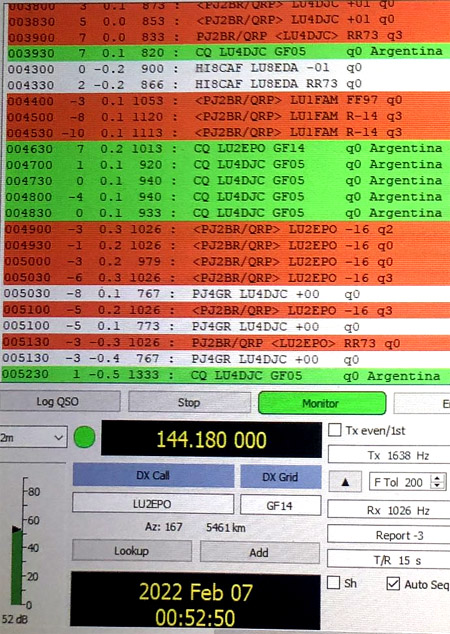9th February 2022: There was another TEP (Trans-Equatorial Propagation) opening on 144 MHz between the Caribbean and South America but this time, it was a bit unusual.
As the map above shows, nearly all of the signals shown on the PSK Reporter website were from Argentina to Aruba, Bonaire, Curacao and the Dominican Republic. There was also some from Argentina to Puerto Rico. What was unusual was the lack of signals further east from Puerto Rico to the south of Brazil.
Usually there are two parallel TEP paths crossing the Geomagnetic Equator. For whatever reason, the eastern path to Brazil seems to have been mostly absent.
Spots on the DX Cluster show a small bit of activity from Puerto Rico to Brazil but it seems to have been at a very low level compared to the path further west.
Spotter Freq. DX Time Info Country
NP4BM-@ 144180.0 LU2EPO 01:03 09 Feb tnks tep q65b qso Argentina
NP4BM-@ 144180.0 LW2DAF 01:01 09 Feb tnks tep q65b qso Argentina
PY5EK 144180.0 WP3DN 23:53 08 Feb Q65B -9 dB 994 Hz TNX TEP Puerto Rico
The path from PY5EK in Brazil to WP3DN in Puerto Rico was the only one I noticed on the PSK Reporter website.
As for why the western TEP path was better than the eastern TEP path???
144 MHz Report... Martin, PJ4MM in Bonaire reports working the following stations in Argentina...
2022-02-09,00:43:15,2022-02-09,00:46:31,LU2EPO,GF14FW,144.181550,Q65,+05,+03,1300,Q65 Sent: +05 Rcvd: +03,,TEP
2022-02-09,00:47:15,2022-02-09,00:48:01,LU4DJC,GF05PO,144.181550,Q65,+06,+02,1300,Q65 Sent: +06 Rcvd: +02,,TEP
2022-02-09,00:48:30,2022-02-09,00:50:01,LU5CQC,GF05SK,144.181550,Q65,+04,+10,1300,Q65 Sent: +04 Rcvd: +10,,TEP
2022-02-09,00:51:45,2022-02-09,00:53:30,LU8EDA,GF05RJ,144.181550,Q65,-11,+05,1300,Q65 Sent: -11 Rcvd: +05,,TEP
2022-02-09,00:54:30,2022-02-09,00:55:01,LU2DPW,GF05GI,144.181550,Q65,-15,-09,1300,Q65 Sent: -15 Rcvd: -09,,TEP
2022-02-09,01:13:45,2022-02-09,01:14:31,LW2DAF,GF05RK,144.181550,Q65,+03,+00,1300,Q65 Sent: +03 Rcvd: +00,,TEP
2022-02-09,01:16:30,2022-02-09,01:21:01,LU9FVS,FF97NC,144.181550,Q65,-10,-01,1300,Q65 Sent: -10 Rcvd: -01,,TEP
2022-02-09,01:21:45,2022-02-09,01:24:01,LU5CQC,GF05SK,144.181550,Q65,+01,+03,1000,Q65 Sent: +01 Rcvd: +03,,TEP
2022-02-09,02:04:30,2022-02-09,02:07:00,LU8GMM,GG02MN,50.314400,FT8,+20,-14,35,FT8 Sent: +20 Rcvd: -14,,TEP
Most of these contacts were in the region of 5,000 kms.
For the TEP contacts with Argentina, PJ4MM was using 100-watts to a 13-element Tonna Yagi which is 13 metres above ground level.










































